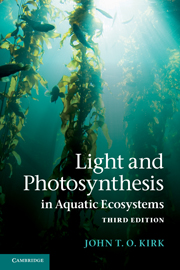Book contents
- Frontmatter
- Contents
- Preface to the third edition
- Part I The underwater light field
- Part II Photosynthesis in the aquatic environment
- 8 The photosynthetic apparatus of aquatic plants
- 9 Light capture by aquatic plants
- 10 Photosynthesis as a function of the incident light
- 11 Photosynthesis in the aquatic environment
- 12 Ecological strategies
- References and author index
- Index to symbols
- Index to organisms
- Index to water bodies
- Subject index
- Plate Section
8 - The photosynthetic apparatus of aquatic plants
Published online by Cambridge University Press: 05 January 2013
- Frontmatter
- Contents
- Preface to the third edition
- Part I The underwater light field
- Part II Photosynthesis in the aquatic environment
- 8 The photosynthetic apparatus of aquatic plants
- 9 Light capture by aquatic plants
- 10 Photosynthesis as a function of the incident light
- 11 Photosynthesis in the aquatic environment
- 12 Ecological strategies
- References and author index
- Index to symbols
- Index to organisms
- Index to water bodies
- Subject index
- Plate Section
Summary
In Part I, we considered the underwater light climate: the particular characteristics that it has in different types of natural water bodies, the scattering and absorption processes that take place in the aquatic medium, and the ways that these operate upon the incident light stream to produce the kinds of underwater light field that we observe. Now, in Part II, we turn our attention to the utilization of this underwater light for photosynthesis by aquatic plants. We begin, in this chapter, by asking: with what intracellular structures, from the level of organelles down to that of molecules, do aquatic plants harvest radiant energy from the underwater light field and convert it to chemical energy?
Chloroplasts
In eukaryotic plants, photosynthesis is carried out by the organelles known as chloroplasts, the best known members of the great class of related and interconvertible organelles known as plastids. Detailed accounts of these organelles may be found in Kirk and Tilney-Bassett (1978), Staehelin (1986) and Falkowski and Raven (2007): we shall here content ourselves with a rather brief treatment.
- Type
- Chapter
- Information
- Light and Photosynthesis in Aquatic Ecosystems , pp. 265 - 307Publisher: Cambridge University PressPrint publication year: 2010



